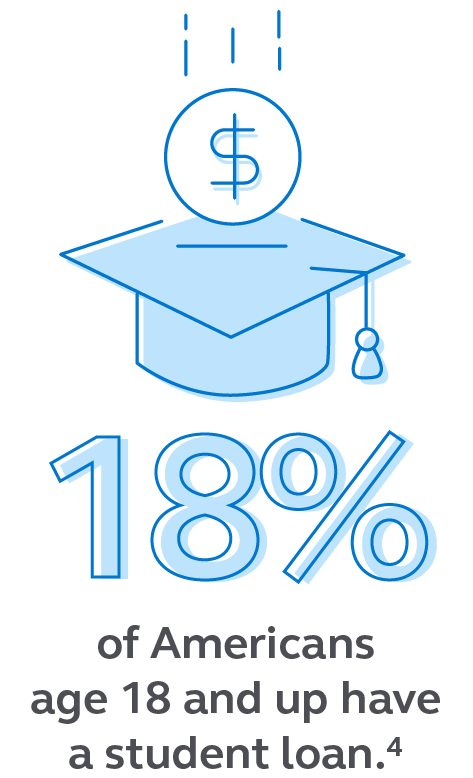About two-thirds of graduating high school seniors head off to college, paying an average of more than $35,000 per year.1, 2 By the time they finish their education, those same students amass an average of $31,000 in debt.3
Many parents and caregivers would do a lot—including raiding their own retirement savings—to help their kids escape that debt burden. After all, retirement might be decades in the future. College costs? Those bills are right here, right now.
The choice isn’t that simple, though, and the impulse to help can come at a steep cost to your own retirement goals. Should you ever use retirement savings to pay for college for your loved ones? Here are five reasons why you may want to avoid it.
1. You can’t borrow for retirement.
About 18% of Americans age 18 and older have a student loan.4 How many retirees can take out cost-of-living retirement loans? None. No financial institution will lend you money to pay for food, health care, and other living expenses in retirement.
“As parents, we want to give our children more than what we had—it’s natural,” says Stanley Poorman, financial professional with Principal®. “But make sure you’re secure first. You’re the foundation, and if that’s weak the whole house might fall. Once you’re certain your goals are secure, then you can focus on making your child’s education secure.”

“You’re the foundation, and if that’s weak the whole house might fall. Once you’re certain your goals are secure, then you can focus on making your child’s education secure.”
Stanley Poorman, financial professional
2. You may have to save more in the future if you withdraw retirement savings now for college expenses.
Let’s say you’ve decided to take out about two years of college expenses from your retirement savings to help a loved one pay for college—approximately $70,000. That withdrawal affects your retirement savings in three ways:
- You may have to find room in your budget to make up those lost savings. How quickly can you replace $70,000?
- You may lose out on future gains. Time in the market matters, and those savings won’t grow for your future retirement if you withdraw them now.
- You may have to pay early withdrawal penalties and taxes. If you’re younger than age 59½, the IRS will impose a 10% penalty on 401(k) withdrawals.
3. Your student may have options to attend and pay for college. You don’t have the same options to pay for retirement.
There are nearly 1,500 two-year colleges and more than 2,800 four-year degree-granting institutions in the country,5 plus 26,000 apprenticeship programs.6
The point? Students have options—lots of options—to pursue higher education. A choice that sets them up for decades of debt may not be worth the investment, even if the institution has high-end name recognition attached. “Discuss all the impacts as a family,” Poorman says. “There are some impacts that you can make up and some you cannot; weigh everything.”
4. Your college student may have repayment options for student loans.
Your college student is right to think carefully about taking on loans (and about how they’ll pay them off). When lenders look at a credit rating, they pay particular attention to the debt-to-income ratio (DTI), or simply the ratio of your income to what you owe and your expenses. The goal is a DTI of about 36%. For graduates with student loans, however, the DTI is nearly 55%.7
Several income-focused repayment plans and federal loan forgiveness programs might help. Some of the former adjust what’s due based solely on income, while others graduate payments over time. Loan forgiveness options generally apply to people in certain jobs or sectors, such as public service. All are available for those who borrow from federal programs, but not private loans—meaning, read carefully (very carefully) before you agree to any loan.
In addition, “fill out FAFSA and see what college aid is available,” Poorman says. That includes discussing an individual package with an institution’s financial aid office.
5. You can adjust your college savings goals.
Eighteen years ago, maybe you promised yourself you’d pay for every cent of your kid’s college expenses. But goals and budgets change, and it’s OK to adjust. That’s especially true if you’re considering withdrawing from retirement accounts to pay for college.
Get creative and reevaluate how you’ll fund each year of college. Maybe one year, a financial aid package covers all the bills. Maybe the next year college savings can pay for everything except books.
“There are tradeoffs to everything, but retirement really is on you—you can’t necessarily count on anyone or anything else.”
Stanley Poorman
“There are tradeoffs to everything, but retirement really is on you—you can’t necessarily count on anyone or anything else,” Poorman says.
Next steps
- Can you save more this year to help speed up your retirement savings? Log in to your Principal account to check your progress. First time logging in? Create an account.




